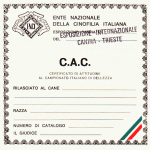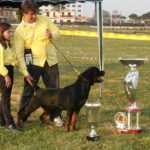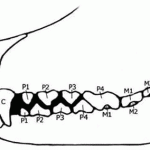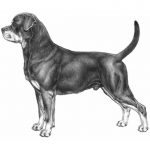probably out, like all the mastiffs, mastiffs from Epirus and the Roman Empire, relative of the Bulldog of Great Britain, of the Middle Ages Alans, of the mastiffs and small mastiff type dogs France, the bulldog we know is the product of different crossings done by enthusiastic breeders in the popular quarters of Paris in the years 1880. At that time, by stevedores dog, butchers and coachmen of the general markets (Halles), He was able to conquer the high society and the world of the artists with his physical appearance so special and its character. It spread rapidly. The first breed club was founded in 1880 Paris. The first register of entries is the 1885 and the first standard was established in 1898, year in which the Société Centrale Canine recognized breed French Bulldog. The first dog of this breed was presented on display in 1887. the standard was modified in 1931-1932 It is in the 1948; It was revised in 1986 the Reant and R.Triquet (FCI publication 1987), then in 1994 by Club Français Committee of the Bulldog with the collaboration of R. Triquet.
General Appearance
| CODE FCI | 101 |
| GROUP | 9 – COMPANION DOGS |
| SECTION | 11A – Molossoids SMALL |
| VARIETY | A – EXTENDED WITHOUT WHITE SPOTS B – WHITE SPOTS WITH EXTENDED |
 © NKU
© NKUplaying Selected
TO KNOW US BETTER
BULLDOG INGLESE
FCI Standard N° 101 / 17.04.2015
NAME: French Bulldog
ORIGIN: France
Date of publication of the original standard in force: 03.11.2014
USE: Companion dog and guard
CLASSIFICATION F.C.I.
Group 9 Pet dogs
Section 11 Small Molossian
Breed not subjected to working trial
BRIEF HISTORY
It follows in all probability, like all the mastiffs, mastiffs from Epirus and the Empire
Romano, relative of the Bulldog of Great Britain, Alani of the Middle Ages, of mastiffs
(mastiffs) and small mastiff type dogs (doguins) of France, he Bulldog che
we know we are the product of different crossings made by passionate breeders in neighborhoods
popular in Paris around the year 1880. At that time, by market surge dog
General Parisians, butchers and coachmen, He was able to conquer the high society and the world of
artists thanks to his physical appearance so special as well as to his character, spreading
quickly. The first breed club was founded in 1880 Paris. The first Register of
Origins was opened in 1885 and the first breed standard was drafted in 1898, year in which
also the Société Centrale Canine recognized French Bulldog. The first example
the breed was introduced on display in 1887. The Standard was modified in 1931-
1932 It is in the 1948; It was revised in 1986 H. F. Reana e R. Triquet (Publication date FCI,
1987), again in 1994 from the Club Committee of the Bulldog français
collaboration of R. Triquet, then in 1994 by Violette Guillon (Data on
FCI publication, 1995) It is in the 2012 from the Club Committee of the Bulldog francais.
GENERAL APPEARANCE
Typical small molossoid. Mighty in even small size, short, thickset,
collected in all its proportions, a short hair, with short snout, pug nose, ears
erected and with naturally short tail. It must appear active, intelligent, very muscular,
compact construction and with a solid backbone. No character should look like this
exaggerated than the other to impair the general harmony of the dog, Oh yes
confer an unpleasant appearance or disturb the movement.
IMPORTANT PROPORTIONS
The length of the body (from the tip of the shoulder to the tip of the buttock) exceeds
little height at withers.
The length of the muzzle is approximately 1/6 of the total length of the head
BEHAVIOR
Companion dog, sociable, lively, playful, sports, awake, possessive.
HEAD
The head must be very strong, wide and square, with skin that forms folds and wrinkles
almost symmetrical, without exaggeration.
REGION OF THE SKULL.
Skull broad, almost flat, with bulging forehead. Protruding eyebrows, separate
by a particularly developed furrow between the eyes. This furrow must not extend up
forehead. Very low development of the occiput. deeply accentuated Stop.
FACIAL REGION.
The head of the bouledogue is characterized by the shortening of the maxillofacial region
nasal, as well as by a slight inclination to the media of the nose backwards. The nose
It is slightly rotated upward.
Truffle: black, long, (short and snub upturned, with large nostrils and
symmetric, that they are directed obliquely backwards. The inclination of the nostrils, come
well as the snub nose (remouchè) They must still allow a normal
breathing.
muzzle: very short, long, with symmetrical concentric wrinkles.
Lips: thick, a bit 'relaxed and black. The upper lip is joined in all'inferiore
central point, completely covering the teeth. The profile of the upper lip is
descending and rounded. Language should never be visible at rest.
Jaws: the jaws are wide and powerful. The lower jaw projects forward
respect to the upper and describes a curve ( = wheel) upward. The arch of
lower incisors is rounded. The jaws must not show any deviation
lateral, or twist. The space between the arches of the incisors should not be
strictly defined; the essential condition is that the upper lip and that
less are so joined to cover the teeth completely. The lower incisors
surpass the upper ones. Incisors and canines must be sufficiently
development. E 'desirable a full dentition.
Cheeks: well developed.
Eyes: clearly visible, lively expression, inserted at the bottom, rather distant from the nose and
ears, dark, large enough, round, do not suggest
no trace of white (sclera) when the dog looks straight ahead. The edges of eyelids
must be blacks.
Ears: medium sized, broad at the base and rounded at the tip. Place on high
head, but not too close, carried erect. The auricle is open toward the
front. The skin is fine and soft to the touch.
NECK
Short, powerful, slightly arched, without dewlap, widening towards the shoulders .
TRUNK
top line: comeback gradually and without excesses from the withers up
to the kidney. This arrangement, also called roach back, It is a feature
purebred.
Back: broad and muscular, solid and without laxity.
Rene: wide and short arcuate.
croup: well-sloped.
Chest: cylindrical and well descended (slightly below the level of the elbows); barrel, with
ribs're very.
Chest: wide and registrable in a square seen from the front.
Belly and flanks: without being detected levrettati
CODA
short course, if sufficient length ideal to cover the anus, insert
low, rather straight, wide at the base, It tapers to a point. A coiled tail,
knotted, broken or relatively long (that does not however goes beyond the tip of the
garretto), it is allowed. The tail is carried low, and also in movement must not
exceed the horizontal line.
MEANING
FRONT: vertical and parallel when viewed laterally and frontally (well in perpendicularly).
Shoulder: It must be well inclined (oblique).
short arm, often, muscled, slightly curved.
Elbows: Close to body, without results.
Forearms: short, straight and muscular.
Carpo: solid and short.
Metacarpo: short and slightly inclined seen in profile
Feet: round, compact, small size ("Cat feet"), slightly rotated out.
Fingers tight with short nails, thick and black.
POSTERIORI: Strong and muscular, I am a bit 'longer than the front, in order to make
the highest rear. The legs are vertical and parallel views from profile and from behind
(regular aplomb).
Leg: muscled, solid.
Garretto: rather descended, not too angulated, nor right.
Tarsus: solid
etatarso: short..
FEET
Rotondi, compact, not rotated inwards or outside.
GAIT
loose Movement, powerful and fluid; limbs move parallel to the median plane
the seen from the front and in profile body.
COAT
FUR: the shallow, thick, shiny and soft, without undercoat.
SKIN: I tesa.
COLOR: tawny, brindle or less, with or without white markings (“panachure” = white
spotting).
COATS WITHOUT WHITE SPOTS (EXTENDED)
tawny: uniform coat color that ranges from light fawn to fawn load, sometimes
with the presence of a lighter color in dependent parts, with or without a mask
Black, although its presence is to be preferred. Limited white patches
extension may be present.
BRING': cloak fawn average crossed by transversal dark streaks that
create the effect of a "tabby stripes"; streaks must never be so
extended to cover the fawn colored background. A black mask may be present.
White spots of limited extent may be present
COATS WITH WHITE SPOTS (EXTENDED)
Bringe 'WITH WHITE SPOTS OF MEDIUM OR INVASIVE: say
"QUAIL" (“pied”), the spots are ideally located throughout the body. Some
patches on the skin are allowed.
Fawn with WHITE SPOTS OF MEDIUM OR INVASIVE : say
"WHITE / fawn", the spots are ideally located throughout the body. Some
patches on the skin are allowed.
In all types of coat your nose is always black, Never brown or blue.
The entirely white dogs (with fully invasive white spot), a
provided that rhyme nose and eyelid are blacks, They are permissible but not sought
for the risks associated with deafness.
SIZE AND WEIGHT
HEIGHT AT WITHERS: males from 27 a 35 cm; females 24 a 32 cm; tolerance: 1
cm above or below the established limits
WEIGHT: men: 9 14 Kg; females: 8 13 Kg; a tolerance of 500 g is in excess
if the subject is well within the type
DEFECTS
Any deviation from the above must be considered a fault and the seriousness with which
This will be penalized must be proportionate to its degree:
• caille coat heavily black moschettato
• White coat fawn heavily flecked red
• in the mantle fawn, trace of deep black color that extends over the back
• in tawny coats bringé and presence of white socks
• clear fingernail
FAULTS
• hypertype, exaggeration of breed features
• nose too long or excessively short
• visible tongue in my mouth shut
• light eyes (predatory)
• horizontal top line from withers to the kidney
• Excessive depigmentation of the lips, nose or eyelids, which does not rhyme
It should never be completely depigmented
closing pincer.
FAULTS
• aggressive or fearful subjects
• any person clearly showing physical abnormalities or
behavior should be disqualified
• Lack of type: Insufficient breed characteristics and such that the subject does not
looks to others of the same race
• Fully closed nostrils
• torsion or lateral deviation of the mandible with constantly visible tongue
• subjects with lower incisors are located behind the upper ones
• individuals with permanently visible canines also humming
• eyes eterocromi
• different color from black truffles
• not erect ears
• anurismo or tail ingrown
• Presence of dewclaws on hind legs
• hocks reversed
• long hair, hard or wooly
• coat color does not comply with the provisions of the standard, in particular
nero, black with fawn markings and all black dilutions with or without spots
white
• size and weight beyond the limits of the standard
• individuals who show signs of respiratory distress
deafness
.B Male animals should have two apparently normal testicles fully
descended into the scrotum
nly healthy subjects and capable of performing the functions for which
They were
selected and which have a typical breed conformation, they can be
used in
reproduction
Related Posts
NEWS MOST 'INTERESTING
on our blog all the most interesting news about the world of dog world. If you are interested in some information about expo, dog health, breeding Dell'Antico Warrior, you can not find. Contact us we shall be glad to publish some post about it.







